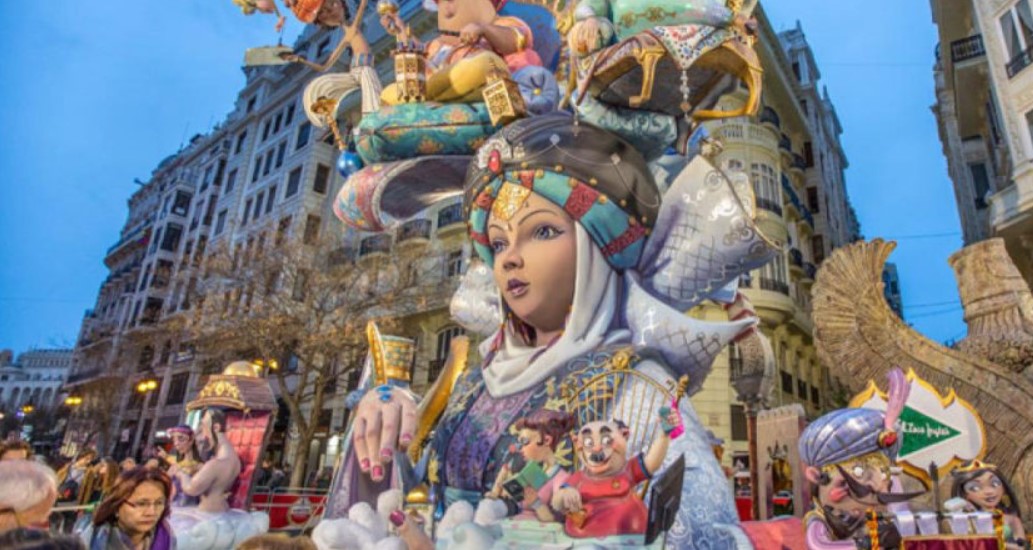With fall travel rapidly approaching, now is the time for travelers to pack their bags and fly to Valencia, Spain. This year, travelers are in luck as the Las Fallas Festival—usually celebrated in March, has been pushed to September for the first time in history. One of the three UNESCO Heritage designations in the city, the five-day festival is an annual tradition celebrated in commemoration of Saint Joseph. From September 1st to September 5th, travelers visiting the city will witness continuous partying with locals cooking paellas on the streets, throwing firecrackers, and marching behind their fallas monuments – unique and colorful constructions crafted by neighborhood teams – to the beat of the lively music that fills the streets. Greeting travelers upon their arrival to the Valencia Airport, there will be an interactive exhibition about Las Fallas, so that all visitors can learn more about the fire festival and be encouraged to witness the Fallas first-hand.
The Las Fallas Festival gives visitors the opportunity to learn about the traditions and cultures of the Spanish city in an exhilarating way. This incredible celebration will make any traveler feel the intense emotion and excitement that comes from its multiple events and appreciate the immense creative potential of all the people involved—the artists, costume designers, musicians, artisans, pyrotechnicians and of course, the locals. Throughout this festival, visitors will marvel at the fallas, grand-scale statues made of papier-mâché and other materials, which are the heart and soul of the festival that fill the streets of Valencia in a unique demonstration of creative capacity.
Travelers will also feel their bodies rumble in response to the greatest symbol of the festival—gunpowder and fire celebrations.
While the festival is an almost week-long ongoing party, there are seven events that travelers can’t miss in order to get the full Valencian experience:
La Mascletà (Sept. 1st – 5th): Every day of the festival at 2:00 p.m. each neighborhood in the city hosts its own Mascletà, which is an incredibly lively display of firecrackers that reaches up to 120 decibels.
Nit de L’albà (Sept. 1st): Nit de L’albà is a fireworks display around the city that takes place at midnight over the fallas monuments and puts an eventful end to the first night of the festival.
La Plantà (Sept. 2nd): Next is La Plantà, when the fallas are built and finalized in preparation for the festival. Each Valencian neighborhood enters their monument into a competition in hopes of being chosen the next day as the winner—or the ninot indultat, which is the only monument that is saved from the burning on the final day and is exhibited in the local Museum Fallero.
La Ofrenda (Sept. 3rd-4th): On the third and fourth days of the festival, La Ofrenda takes place, also known as the flower offering.
During these days, a large statue of the patron saint of Valencia is placed in the Plaza de la Virgen and locals gather to offer up bouquets of flowers.
By the end of the fourth day the plaza becomes a sight for sore eyes, covered in flowers and with a marvelous aroma from the thousands of flowers that have been offered.
Nit del Foc (Sept. 4th): Translating to Fire Night, the Nit del Foc takes place on the fourth night and is the night of the incredible fireworks display, beginning at 1:30 a.m.
Cavalcada del Foc (Sept. 5th): The final day of the festival begins around 7:00 p.m. with the Cavalcada del Foc, a colorful fire parade with floats, street performances, people in costumes and lively music.
La Cremà (Sept. 5th): The grand finale of the entire festival and the moment that every event has led up to is La Cremà, when all the fallas are set on fire in an incredible display that ends in a pile of ashes.
Travelers unable to attend the famous fire festival this year are always welcome visit to the local Museum Fallero to see the winning fallas and learn about the celebration. Those who visit Valencia for the festival can also delight in mouthwatering gastronomy, explore the ultra-modern City of Arts and Sciences, and explore the remaining two UNESCO Heritage Designations: La Lonja de la Seda (The Silk Exchange) and El Tribunal de las Aguas (The Water Tribunal).

